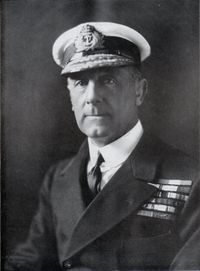Jellicoe:Director of Naval Ordnance
| ||||||||
In his memoirs Jellicoe related his taking up the position of Director of Naval Ordnance (D.N.O.):
On leaving the Drake on Nov 21st 1904 I went to the Admiralty to serve on the Committee associated with Sir John Fisher's work there as 1st Sea Lord, an appointment which he had taken up on Oct 21st. The remaining members of the Board Lord Selborne (1st Lord) Admiral Sir Charles Drury (2nd Sea Lord) Admiral Sir William May (Controller) and Admiral F. S. Inglefield (4th Sea Lord). I was particularly detailed to consider the designs of the new Battleship which it was intended to arm entirely with 12 inch guns instead of the mixed armament which had been the rule hitherto.[1] Eventually the design of HMS Dreadnought was selected, but before this decision was reached I had taken up the appointment of Director of Naval Ordnance dated 24/2/1905. I was still associated with the design of this new battleship while holding this appointment.
In those days the staff of the D.N.O. composed an Assistant Director of Torpedoes, three officers of Commanders or Lieutenants rank for gunnery work, three for torpedo work and a marines' officer for general duties.
On coming to London my wife and I took up our residence at 25 Dreycott Place, where our second daughter Betty was born in 1905. Our third daughter Myrtle being born at my father in law's house in Belgrave Square in 1908.[2]
Jellicoe was appointed to the Admiralty "for committee" work on 14 November, 1904.[3] On 30 December Jellicoe's younger brother, Lieutenant Edmund Henry Jellicoe, who had been appointed in command of the destroyer Whiting on 11 October, was found dead in his cabin with a bullet wound to the head. The Court of Enquiry found that he had shot himself "whilst suffering from nervous disability."[4]
On 3 January, 1905, he wrote to fellow gunnery expert Captain Reginald G. O. Tupper:
Very many thanks for your congratulations. I can't say I care about the job much especially if it prevents my finishing off my Captain's time at sea but one must go where one is sent. I hope we may develop battle firing soon with fleet firing but I think we must first get some decent communications into ships & calibrate the guns. I hope we shall improve a lot on the battle practice yet. There is certainly room for improvement.[5]
Jellicoe later recalled in connection to the Dreadnought:
As for the criticisms of Lord Fisher's action in initialising the Dreadnought class, the reply is simply that his actions were based upon the extreme difficulty of obtaining accurate fire control & consequently accurate shooting in a ship with a mixed armament of 12" and 9.2" or 12" and 10" guns. This difficulty entirely disappeared when the heavy gun armament composed guns of one calibre alone.[6]
On the occasion of the King's visit to Portsmouth to launch the battleship Dreadnought Jellicoe was appointed a Commander in the Royal Victorian Order (C.V.O.) on 10 February, 1906.[7] On 8 March he was appointed a Naval Aide-de-Camp to King Edward, vice Marx.[8]
Appearing before the Douglas Committee on the status of Engineering and Marine Officers in December, 1906, Jellicoe gave his views on discipline:
I find that the smaller the number of officers who can punish the bigger is the the punishment when awarded, and the fewer punishments there are. Petty punishments, I always think, are a very bad thing for the men, and I would much sooner come down on a man once or twice than constantly be sentencing him to three days 10 A.[9]
On 8 February, 1907, Jellicoe was promoted to the rank of Rear-Admiral, vice Powell.[10] On the occasion of the King's inspection of the Home Fleet he was appointed a Knight Commander in the Royal Victorian Order (K.C.V.O.) on 3 August.[11]
As Director of Naval Ordnance, Jellicoe commented on the armament of new ships. For unarmoured cruisers of the 1908-1909 programme, he wrote in June, 1907, that they ought to be armed with 4-inch guns, reasoning that "One of the difficulties an Admiral often has to contend with is the not unnatural tendency of cruiser captains to fight instead of collecting and forwarding information … if the calibre of gun is kept down to 4 inch, the temptation to fight largely disappears."[12]
Footnotes
- ↑ Note by Jellicoe: There was one very great disadvantage in this mixed armament, connected with the control of fire and the substitution of one pattern of guns for the main armament had very great advantages in this respect. In spite of this, for some reason afterwards we built light cruisers with a mixed armament of 6" guns and 4" guns, a step against which I always protested.
- ↑ British Library. Jellicoe Papers. Add. MSS. 49038. f. 53.
- ↑ Jellicoe Service Record. ADM 196/38. f. 691.
- ↑ Jellicoe [Edmund] Service Record. ADM 196/44. f. 238.
- ↑ Tupper Papers. National Museum of the Royal Navy, Portsmouth. 1987/130 (88).
- ↑ British Library. Jellicoe Papers. Add. MSS. 49038. f. 207.
- ↑ The London Gazette: no. 27885. p. 1037. 13 February, 1906.
- ↑ The London Gazette: no. 27897. p. 2061. 23 March, 1906.
- ↑ ADM 116/832. p. 158.
- ↑ The London Gazette: no. 27993. p. 899. 8 February, 1907.
- ↑ The London Gazette: no. 28048. p. 5390. 6 August, 1907.
- ↑ "Statement by Rear-Admiral Sir John Jellicoe when Director of Naval Ordnance on the Subject of the Armament of the Cruisers for the 1908-1909 Programme." Tweedmouth Papers. Royal Naval Museum, Portsmouth. MSS 252/9/1.
Bibliography
